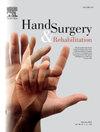Post-burn carpal tunnel syndrome: A systematic review
IF 1
4区 医学
Q4 ORTHOPEDICS
引用次数: 0
Abstract
Objectives
Post-burn neuropathy is a little-known pathology. However, the nerve is the most sensitive organ to burns, especially electrical burns. Carpal tunnel syndrome is the most common mononeuropathy worldwide and the most common post-burn neuropathy. The aim of this study is to evaluate, through a review of the literature, the specificities of the management of mononeuropathy of the median nerve at the wrist occurring at a distance from the burn injury.
Methods
A comprehensive search of the literature was conducted using the Cochrane Library, PubMed, and EMBASE. We included all articles that mentioned nerve injury associated with burns and excluded those that did not address the median nerve or in which the median nerve was the subject of early release. For each study, we compared diagnostic methods and patient management elements. We propose to associate to this review the case of a 23-year-old male victim of an electrical burn who developed a carpal tunnel at a distance from his burn. The patient underwent surgery and was evaluated 1 mo and 6 mo after surgery using grip strength, Weber’s two-point discrimination test, QuickDASH, and BCTSQ questionnaires. An electromyogram was performed preoperatively and 6 mo postoperatively.
Results
Thirteen articles met the inclusion criteria and were reviewed. The majority of these involved electrical and thermal burns, with TBSA ranging from 2% to 65%. The affected population was young (36.7 years) and predominantly male. The mean hospital stay was 59.1 days, compared with 137.5 days for diagnosis delay. Diagnostic electromyography was not always performed. No study used ultrasound or MRI to look for an etiology other than burns in the development of carpal tunnel syndrome. All studies that reported symptom improvement after treatment did not use a functional score. In our case, grip strength on the operated side improved moderately. Discriminative sensation was restored. QuickDASH and BCTSQ scores were initially poor and improved very modestly after surgery. Electromyography showed recovery of sensory conduction but no recovery of motor conduction.
Conclusion
Carpal tunnel syndrome can have significant functional consequences in burn patients because it is often overlooked and treated late. Early clinical and electromyographic diagnosis is essential to ensure surgical management before irreversible intra-neural injury occurs. Ultrasound could be useful for the early detection of signs of median nerve injury at the wrist when electromyography is not possible, and to verify the absence of another associated etiology in the development of carpal tunnel syndrome after burns. We propose a decision algorithm for the management of carpal tunnel syndrome associated with burns.
Level of evidence
IV.
烧伤后腕管综合征:系统回顾。
目的:烧伤后神经病变是一种鲜为人知的病理。然而,神经是对烧伤最敏感的器官,尤其是电烧伤。腕管综合征是世界上最常见的单神经病变,也是最常见的烧伤后神经病变。本研究的目的是通过对文献的回顾,评估在距离烧伤远处发生的手腕正中神经单神经病变的治疗特异性。方法:利用Cochrane图书馆、PubMed和EMBASE进行文献检索。我们纳入了所有提到与烧伤相关的神经损伤的文章,并排除了那些没有涉及正中神经或正中神经是早期释放主题的文章。对于每项研究,我们比较了诊断方法和患者管理要素。我们建议将这一审查的情况下,一个23岁的男性受害者的电烧伤谁发展了腕管距离烧伤的距离。患者接受手术治疗,术后1个月和6个月分别采用握力、韦伯两点辨别测验、QuickDASH和BCTSQ问卷进行评估。术前及术后6个月行肌电图检查。结果:13篇文章符合纳入标准。其中大多数涉及电和热烧伤,TBSA从2%到65%不等。受影响人群为年轻人(36.7岁),以男性为主。平均住院时间为59.1天,而诊断延误为137.5天。诊断性肌电图并不总是进行。在腕管综合征的发展过程中,没有研究使用超声或MRI来寻找除烧伤以外的病因。所有报告治疗后症状改善的研究都没有使用功能评分。在我们的病例中,手术侧的握力有所改善。辨别力恢复了。QuickDASH和BCTSQ评分最初很差,手术后略有改善。肌电图显示感觉传导恢复,但运动传导未见恢复。结论:烧伤患者腕管综合征因其易被忽视和治疗较晚而对功能造成严重影响。早期临床和肌电图诊断是必不可少的,以确保在不可逆的神经损伤发生之前进行手术治疗。当肌电图不可能时,超声可用于早期发现手腕正中神经损伤的迹象,并验证烧伤后腕管综合征的发展中是否存在其他相关病因。我们提出了一个决策算法的管理腕管综合征与烧伤。证据等级:四级。
本文章由计算机程序翻译,如有差异,请以英文原文为准。
求助全文
约1分钟内获得全文
求助全文
来源期刊

Hand Surgery & Rehabilitation
Medicine-Surgery
CiteScore
1.70
自引率
27.30%
发文量
0
审稿时长
49 days
期刊介绍:
As the official publication of the French, Belgian and Swiss Societies for Surgery of the Hand, as well as of the French Society of Rehabilitation of the Hand & Upper Limb, ''Hand Surgery and Rehabilitation'' - formerly named "Chirurgie de la Main" - publishes original articles, literature reviews, technical notes, and clinical cases. It is indexed in the main international databases (including Medline). Initially a platform for French-speaking hand surgeons, the journal will now publish its articles in English to disseminate its author''s scientific findings more widely. The journal also includes a biannual supplement in French, the monograph of the French Society for Surgery of the Hand, where comprehensive reviews in the fields of hand, peripheral nerve and upper limb surgery are presented.
Organe officiel de la Société française de chirurgie de la main, de la Société française de Rééducation de la main (SFRM-GEMMSOR), de la Société suisse de chirurgie de la main et du Belgian Hand Group, indexée dans les grandes bases de données internationales (Medline, Embase, Pascal, Scopus), Hand Surgery and Rehabilitation - anciennement titrée Chirurgie de la main - publie des articles originaux, des revues de la littérature, des notes techniques, des cas clinique. Initialement plateforme d''expression francophone de la spécialité, la revue s''oriente désormais vers l''anglais pour devenir une référence scientifique et de formation de la spécialité en France et en Europe. Avec 6 publications en anglais par an, la revue comprend également un supplément biannuel, la monographie du GEM, où sont présentées en français, des mises au point complètes dans les domaines de la chirurgie de la main, des nerfs périphériques et du membre supérieur.
 求助内容:
求助内容: 应助结果提醒方式:
应助结果提醒方式:


